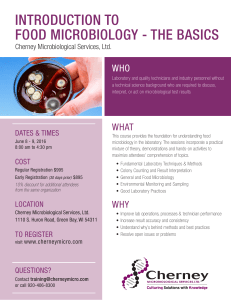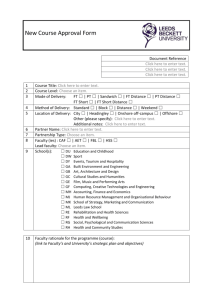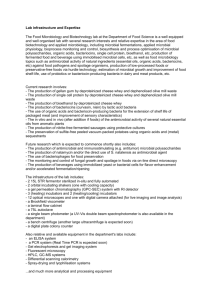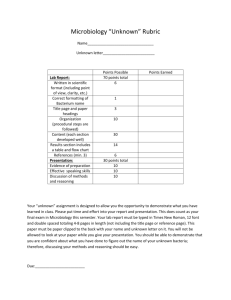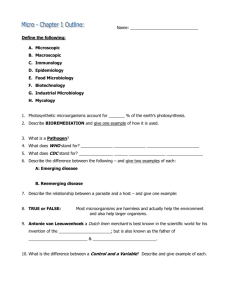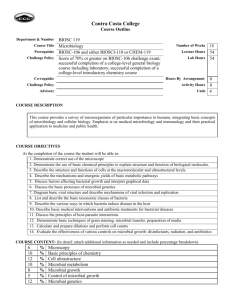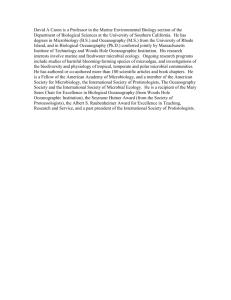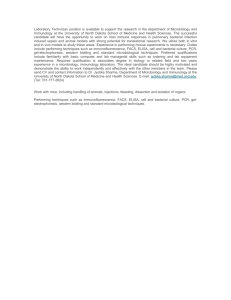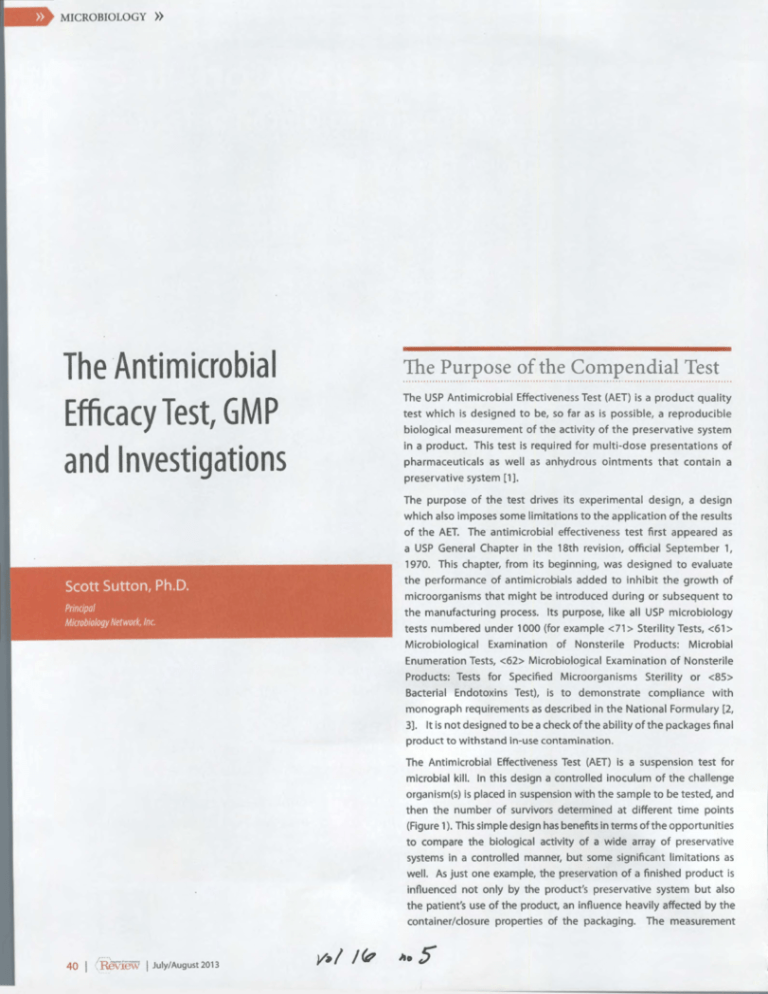
MICROBIOLOGY ))
The ·Antimicrobial
Efficacy Test, GMP
and Investigations
The USP Antimicrobial Effectiveness Test (AET) is a product quality
test which is designed to be, so far as is possible, a reproducible
biological measurement of the activity of the preservative system
in a product. This test is required for multi-dose presentations of
pharmaceuticals as well as anhydrous ointments that contain a
preservative system [1 ].
The purpose of the test drives its experim.e ntal design, a design
which also imposes some limitations to the application of the results
of the AET. The antimicrobial effectiveness test first appeared as
a USP General Chapter in the 18th revision, official September 1,
1970. This chapter, from its beginning, was designed to evaluate
the performance of antimicrobials added to inhibit the growth of
microorganisms that might be introduced during or subsequent to
the manufacturing process. Its purpose, like all USP microbiology
tests numbered under 1000 (for example <71 > Sterility Tests, <61 >
Microbiological Examination of Nonsterile Products: Microbial
Enumeration Tests, <62> Microbiological Examination of Nonsterile
Products: Tests for Specified Microorganisms Sterility or <85>
Bacterial Endotoxins Test), is to demonstrate compliance with
monograph requirements as described in the National Formulary [2,
3]. It is not designed to be a check of the ability of the packages final
product to withstand in-use contamination.
The Antimicrobial Effectiveness Test (AET) is a suspension test for
microbial kill. In this design a controlled inoculum of the challenge
organism(s) is placed in suspension with the sample to be tested, and
then the number of survivors determined at different time points
(Figure 1). This simple design has benefits in terms of the opportunities
to compare the biological activity of a wide array of preservative
systems in a controlled manner, but some significant limitations as
well. As just one example, the preservation of a finished product is
influenced not only by the product's preservative system but also
the patient's use of the product, an influence heavily affected by the
container/closure properties of the packaging. The measurement
40
I
(~ew
I July/August2013
v~l
Jft?
MICROBIOLOGY ))
,......
Table 1. Example SOP Listing to Support Antimicrobial
Effectiveness Testing
Incubate microbial
mtpention
IfiCFU/mL a
Each of five
challenge
microorganisms
- 3 bacteria,
2 fimgi
,_..__
a mttt~
10-fold serial dilution•
•
Plate in growth apr
to count lllrVivors
~
~
Sample at
appropriate times
Detmnine Loll Rmsim
(log value of inoculwn) (log value of IR.ITVivon at
the time point)
Figure 1. Antimicrobial Effectiveness Test
Topic
Category
Testing
Antimicrobial Preservative Effectiveness Test
Testing
Method Suit<'lbilityTesting for Antimicrobial Effectiveness Test
Testing
Investigations in the Microbiology Laboratory
Testing
Measurement of Inoculum Concentration By Means of% Transmittance
Quality
Structure and Numbering of Documents'
Quality
Format Guidelines for Writing SOPs'
Quality
Good Documentation Practices'
Quality
Approval and Maintenance of Vendors'
Quality
Guidelines for the Use ofVendor Supplied Validation Protocols
Quality
Personnel Signatures'
Quality
Calculating and Reporting Microbiology Data
Quality
Logbooks, Laboratory Notebooks and Worksheets'
of this in-use potential for contamination of the finished product is
Quality
Guidelines for Archiving and Record Retention'
outside the scope of the compendia! AET (see below).
Quality
Corrective and Preventive (CAPA) Program for Microbiological
Laboratory Investigations
There are several variations to the standard AET that have been
Quality
Vendor Audit Procedures'
described in regulatory and trade standards [4-6]. This review will
Training
Microbiology Training Program
be restricted to the tests commonly used in the pharmaceutical, OTC
and medical device industries with emphasis on the USP test [1 ].
Training
OJT and Training Modules
Cultures
Cryopreservation of Bacteria and Fungi
The compendia! tests of the USP and the European Pharmacopeia
have very similar methods, but they differ in sampling points and
Cultures
Maintenance and Quality Control of Monthly Stock Cultures
Cultures
Preparation of Working Cultures for Inocula
acceptance criteria. [6- 8]. In general, both compendia follow a
Cultures
pattern of analyzed product risk - more patent risk for a product
category is associated with increased (and shorter) testing intervals
Enumeration and Release of Organisms for Use In the
Microbiology Laboratory
Media
Preparation of Media for the Microbiology Lab
Media
Receipt and Release of Sterile Media and Reagents
requirements for viable CFU from the inocula (for example, see
Media
Handling, Labeling, and Storage of Chemicals, Reagents, and Solutions
Tables 1 and 3 in reference 1).
Media
Preparation of Culture Media and Reagents
Media
Growth Promotion Testing of Microbiological Media
Lab Operations
Incoming Inspection of Chemical Raw Materials
Lab Operations
Sample Tracking In the Microbiology unit
Lab Operations
Preparation of Disinfectants for Laboratory Use
Lab Operations
Microbiology Laboratory Hygiene and the Use of Disinfectants
over the 28-day period, and more stringent log 10 unit reduction
Demonstration of
-~-~-~~?..~. ~-~~ ~-~-~~~~~Y .......................................................
The measurement of microbial kill requires the ability to measure
the number of surviving microorganisms with time after exposure to
the antimicrobial agent. However, carryover of residual preservative
from the test could inhibit growth in the recovery medium, leading
to poor microbial recovery. This potential residual activity must
be neutralized and it is necessary to demonstrate the adequacy
of neutralization for these tests [9-12]. This demonstration of
neutralization in compendia! microbiological tests is known as
Lab Operations
Receiving Incoming Materials
Lab Operations
Incubation and Enumeration of Microbial Samples
Lab Operations
Microorganism Plate Counting Procedure
Lab Operations
Tube Labeling
Lab Operations
f----·
Lab Operations
Plate counting
Materials Sampling
Lab Operations
Basic Microbiological Calculations
Equipment
Use, Calibration, and Maintenance of Steam Sterilizer (autoclave)
Equipment
Use, Calibration, and Maintenance of Incubators, Refrigerators
and Freezers
As with the overall design of the AET, it is important at the outset to
clearly define the goal of the method suitability study (as described
in the compendia). This goal is not to demonstrate the ability to
recover microorganisms present in the product. If that were the case
then the challenge organisms would be inoculated directly into the
product - they are not. This direct inoculation of the product will
Equipment
Use, Calibration, and Maintenance of Laboratory Balances
Equipment
Use, Calibration, and Maintenance of Pipetmen
Equipment
Use and Maintenance ofWater Baths
Equipment
Microbiology Equipment and the Scheduling and Procedures for
Maintenance, Calibration and Performance Checks
Equipment
Calibration/Maintenance/Performance of pH Meters
not work if the antimicrobial properties of the product are strong as
the product could well kill off all challenge organisms before it was
possible to plate the test organisms. The goal of a microbiological
Equipment
Use, Maintenance and Calibration of the Spectrophotometer
demonstration of method suitability.
42
I
r~eW
I July/August 2013
'These SOPs can be either lab documents or higher level Quality SOPs
((
MICROBIOLOGY
method suitability test is to demonstrate that any residual
antimicrobial properties of the product or the recovery method have
been neutralized, using the challenge microorganisms as a kind of
biological indicator of neutralization.
The overall purpose of a neutralizer evaluation (Method Suitability
Study) is to serve as a control experiment to the preservative system
evaluation (AET). Therefore, replication of the critical parameters
of the AET is critical to the neutralizer evaluation (see below for
determination of"critical parameters" in the discussion of Laboratory
Investigations).
A good overall reference for microbial recovery
studies can be found in USP <1227>"Validation of Microbial Recovery
from Pharmacopeia I Articles" [13].
It is important to note that although at the present time there is not
a method suitabi lity test written into the compendia( AET chapter,
basic GMP requirements call for evidence that a test is suitable for
its intended purpose. Specifically, 27 CFR 27 7. 794 Laboratory Records
states in section (a)(2) "(If the method employed is in the current
revision of the United States Pharmacopeia, ... and the referenced
method is not modified, a statement indicating the method and
reference will suffice [for validation of the assay]). The suitability of
all testing methods used shall be verified under actual conditions of
use:' In other words- a method suitability test.
Microbiology Laboratory
Investigations and Proactive
Documentation
Investigations are a critical area of regulatory concern and there exists
a great deal of confusion about regulatory expectations in this regard.
This confusion is especially noticeable in the area of Microbiology
laboratory investigations. The FDA has provided guidance on the
topic, drafting the "Guidance for Industry - Investigating Out of
Specification (OOS) Test Results for Pharmaceutical Production" [14].
Interestingly, this guidance document only briefly touches upon
microbiological data, stating in section IV.C.1.a. that"... In the case of
microbiological assays, the U.S. Pharmacopeia (USP) prefers the use
of averages because of the innate variability of the biological test
system'~ While this is interesting and undoubtedly true, it does not
help in designing a laboratory investigation. This silence on the part
of the guidance document is explained in footnote 3, which explicitly
excludes biological studies from the scope of the document (this
statement includes microbiological studies).
This guidance document, although written for analytical chemistry
tests, does provide useful guidance to microbiology laboratory
investigations. For example, the FDA guidance's focus on
Our IMD-A• systems monitor controlled areas in real time, detecting
microbes instantaneously so you can act. Our systems utilize
advanced optics and signal processing, requiring no staining, no
reagents, and little human intervention. Let us help shed light on
what may be lurking in your environment.
~w.:
B'•• igllant·
Insta ntaneous Microbial Detection
Know Now. Act Now.
www.biovigilant.com
azbil
July/August 2013
I
R.eView
I
43
MICROBIOLOGY
»
either document mentions a microbial growth medium, a piece
of equipment, a stock culture or a number (temperature range,
duration, frequency, CFU/plate). This list becomes your checklist
for "Critical Factors" (if the parameter is not critical, why specify
it?). With this list in hand, pick a past AET at random and confirm
that all critical items are included in the proactive documentation.
Any failures in documentation found by this gap analysis should
be addressed immediately to assist in future investigations (and
GMP audits!).
Extensive documentation of compliance with the
laboratory's SOP system increases the chances of a successful
AET investigation.
All investigations should happen in a timely fashion. The potential
AET failure should be communicated immediately to the laboratory
supervisor. The investigation should then follow an established
procedure, a procedure that was developed in advance with the
approval of the Quality Assurance Unit (QAU).
The first step of a laboratory investigation is to check for the easy
issues. Look for common data entry errors:
v.
-:>-
No
~
~
...
....
~
.....
0
Incorrect math
Sample dilution series error
Transcription error
Clerical error
If these are found, correct the error under your procedure for such
corrections.
If the lab investigation does not identify correctable
data entry errors as the source of the putative AET failure, then a
Figure 2. Flow Chart of Example AET Laboratory Investigation
investigating a potential laboratory component (with its respective
more complete investigation should be initiated (see Figure 2 for an
example of a possible model for such an AET laboratory investigation).
The overall laboratory investigation should be coordinated though
the QAU as per 21 CFR 211.160.
responsibilities) prior to the full scale investigation is especially
The complexity of the AETas a laboratory process (despite its simple
helpful. Great care should be taken, however, in over-applying these
design) requires that the investigation examine a variety of different
topics as outlined in Figure 2. The evaluation of data records and
documents into areas for which they are not appropriate.
This leaves us with the need to develop our own laboratory
investigation procedures.
The initial question in any potential
test failure is to determine the validity of the test result. This is
especially true of the AET which will be conducted over the period
of a full month and may include contributions from several different
test samples will play a large part of this process. The value of
extensive proactive documentation was described above, but this is
not sufficient for a complete AET investigation. It is also of value to
ensure that the samples showing growth are in fact the challenge
organism (and not a "resistant" contaminant) and that the product
samples are correct. Physical constraints on space may prevent
It is therefore critical to realize that the
retention of all samples and test articles that might be of interest.
lab investigation for any microbiological test is heavily dependent
on proactive documentation acquired during the test. The GMP
However, it is prudent to retain as many of the critical samples as
possible until the successful completion of the test to aid in the
microbiology lab collection of this documentation is aided by a
laboratory investigation of a potential issue.
laboratory technicians.
well-organized SOP system (15]. An example of such a SOP support
system that might be useful in an AET laboratory investigation is
provided in Table 1.
This weJI-organized system also allows for easy identification of
the necessary proactive documentation for the GMP compliant
AET. A useful exercise in this regard is to review the USP chapter
as well as your internal AET procedure, making a list of every time
Specific attention should be given to "confirmatory testing': As noted
above, the AET is conducted over the period of a full month and
may include the contributions of several technicians. The inherent
variability of this test is obvious and it is reasonable to expect a
marginally preserved formulation to fail on occasion due to random
chance. In the author's opinion, this specific situation allows for an
argument to be made in favor of"confirmatory testing" 2 • This decision
Confirmatory testing is generally not recommended as part of an investigation as it is frequently difficult to distinguish from "testing to compliance~ In this case (a marginally
preserved product and the inherently variable test) the author believes it can be a useful check on the variability of the results when done correctly.
2
44
I ReVIew I July/August 2013
«
to go forward with "confirmatory testing" should be guided by SOP
- assay variability is a known quantity in microbiological testing and
procedures should be in place to resolve indeterminate results.
In addition, the biology of the test must be considered in the
interpretation of the data from that AET. For example, a product that
shows no reduction of Aspergillus brasiliensis for 14 days, and then
shows an increase at day 28 is unlikely to be a true failure of the USP
criteria. This situation might be the result
MICROBIOLOGY
into the final determination of the microbial quality of the
preservative system.
If the result of the investigation is that the product did indeed
fail, then the product should be handled as appropriate under
management guidance for OOS.
If the laboratory investigation is inconclusive, the test results are
considered valid. It is important to stress the point again that positive
of spore "clumps" in the inoculum breaking
apart, yielding an apparent increase in
the CFU. The sample should be examined
microscopically for the presence of
hyphael growth- spores do not reproduce,
and a hyphael mat is unlikely to increase
the numbers of colony forming units on a
nutrient agar plate.
The
final
phase
in
the
laboratory
investigation is to close it. The investigator
should determine if the AET failure was the
result of:
Laboratory error (invalid test)
DECIDE
W ITH
CONFIDENCE
Assay variation
Failing product
Inconclusive causes
If the AET failure is determined to be
due to error in lab practice, then the
test may potentially be declared invalid.
An invalid test is, by its nature, not a
valid test and therefore the subsequent
test is not a retest but rather the first
correct performance of the assay. If the
test is invalid, a valid test should be run
immediately to determine compliance.
This determination requires identification
of a root cause for the lab error as well as a
corrective action plan to be put into place
in the laboratory to remedy the error and
prevent its recurrence. This plan should
include a method to measure the efficacy
of the corrective action.
It has to be
stressed that clear evidence of lab error is
required to determine the test invalid. If
the investigation is inconclusive, the data
50 YEAR~f
Identification Expertise
Pushes Robustness of MASS SPEC
to o New Level
• Identification in MINUTES
• Robust Single choice answerS= no second guessing
• Easy to Use software and simple workflow based on customer needs
• 21 CFR Part 11 Software
Innovative software allows centralization of the
technology with remote users
• Consolidate your testing in one site; have 5amples
sent into your main lab
must be held to be valid.
If the putative lab failure was due to assay
variation, a determination should be made
as to the appropriateness of confirmatory
testing (as discussed above).
In the
bioMerieux
Contact Us for More Information
www.biomerieux-industry.comfms
conclusion of the laboratory investigation
there must be a clear rationale of how
confirmatory testing (if used) is factored
July/August 2013
I ..~ew I
45
MICROBIOLOGY
»
referred to a recent discussion of the wide-spread need for inclusion
of B. cepacia in QC testing found in the communications ofTorbeck et
a/ [21] and Sutton [22].
If the decision is made to include additional challenge organism(s) in
the AET, the additional organisms should be chosen with care. Good
potential candidates for in-house AET challenges might be selected by:
Regulatory concerns (has your facility been asked to do
something by an inspector?)
Product concerns (has an organism caused a failure of the
preservative system in one of your products?)
Facility concerns (has your environmental monitoring or
water monitoring programs isolated a specific organism in
high numbers or frequency?)
Figure 3. Sources of Additional Microorganisms for AET
Note that there is no regulatory requirement to add additional
microorganisms to the AET. However, if you decide to do so, it is
evidence is required to invalidate a microbiological laboratory test. All
prudent to have a solid, written justification for the organism chosen
test results are assumed correct unless there is unambiguous evidence
and a well-defined response if that "additional" AET organism should
fail to meet the criteria established for passing the test.
of a laboratory error of sufficient impact to invalidate the test.
A general discussion of investigations can be found in USP chapter
"<1117> Best Microbiological Practices" [16]. The USP notes that
interpretation of microbiological data is difficult and strongly
recommends that the supervisor of the lab should be one with
academic training in microbiology or bacteriology. Microbiological
data requires interpretation; it is not data that can be presented solely
by test results. Investigations should be conducted from a broad
perspective, not only looking at equipment, training, product and
A recent survey benchmarking the practices of companies
performing AET addressed this issue 3• The survey received
172 complete responses. Of these responses, 108 did not add
additional organisms; however, this also means that approximately
37% of the respondents were using additional organisms in the
AET. These respondents cite~ environment monitoring isolates and
isolates from products as the sources of the additional organisms
(see Figure 3).
test, but also the underlying biology associated with the situation.
Simulated In-use Designs
Other Considerations
There are a variety of associated questions and topics surrounding the
determination of antimicrobial effectiveness for a preservative system.
Among these are the use of additional challenge organisms to stress
different aspects of the preservative system and the determination of
antimicrobial efficacy under simulated in-use conditions.
"Extra" Challenge Organisms
··············································································································
Over the years there have been a variety of additional organisms
suggested for inclusion in the AET [6]. Recently this effort has gained
a great deal of emphasis with the realization that Bulkholderia cepacia
·································································································.·············
We have examined the AETas a laboratory test that has value as a
QC test but may not be appropriate for determining the behavior
of the finished product preservative system in the field. There have
been several recommendations for methods to determine the ability
of finished product to withstand in-use conditions.
An example of this approach was taken by the cosmetics industry
in developing an alternative method from the USP antimicrobial
effectiveness test. This assay was then tested by "simulated use"
against several other predictive methods, and compared favorably
to several types of antimicrobial effectiveness testing methods
available at the time [23].
so seems a good choice for a biological challenge [19, 20]. However,
the choice of additional challenge organisms beyond those listed in
A second example is the EMEA recommendation for in-use testing
of preserved products [24]. This topic was reviewed in response to
a preliminary draft of the guidance document prior to \ts nna\\zat \on
[25]. In the authors' opinion, in-use testing for chemical attributes
makes sense if oxidation or evaporation of the preservative is a
concern, especially in gas-permeable containers. The effects of
repeated microbiological challenges is a reasonable consideration,
and should be addressed in the lab by repeated low-level challenge
USP is a difficult one -as an example of this complexity the reader is
studies, or in the field by simulated in-use studies.
is a real health threat to a portion of the population when inhaled,
(the susceptible population consists primarily of cystic fibrosis
patients and those at risk for pneumonia) [17, 18]. In addition, this
microorganism seems adept at overcoming preservative systems and
3
Th is survey was conducted by the Microbiology Network during the first quarter of 2013.
46
I ReVIew I July/August 2013
((
MICROBIOLOGY
is evaluated under this simulated abuse situation. This approach has
the advantages of simulating consumer abuse of the product under
' ' The complexity of the
AET as a laboratory
process (despite its simple
design) requires that the
investigation examine a variety
of different topics.
''
The laboratory-based option using low-level challenges to simulate
repeated microbial challenges has been described by Urban et a/
([26] who used a battery of challenge organisms with multiple, lowlevel inoculations to model a repeated contamination events in
a simulated in-use test. By this method, the sample is challenged
repeatedly over the 28-day in-use shelf-life with a low level (1 02 - 103
CFU/ml) of each organism, and the efficacy of the preservative system
a controlled laboratory setting and may be designed to monitor the
entire in-use shelf life. If this design is used, the volume of product
sample used should be large enough to withstand potential dilution
of the preservative system by multiple inocula {pooling of sample
may be required).
The manufacturer would be well-advised to conduct a simulated inuse preservative efficacy study as part of the product development,
but this will have to be done using in-house resources as there are no
useful regulatory guidance documents for pharmaceutical products
in this area.
Packaging components, especially dispensing closures, can be
important con siderations in preventing microbial contamination
during consumer use. A study by Brannan and Dille [27] showed
that, during consumer use, unpreserved shampoo with a flip-cap
had the greatest degree of protection from contamination {0%). for
an unpreserved skin lotion, a pump-top dispenser afforded the best
protection from contamination (1 0%). Other types of closures tested
Get accurate results in hours, not days
There's too much at stake to take a risk when it comes to contaminant and impurity
testing. That's why more experts are turni ng to Applied Biosystems® SEQ rapid
molecular kits and systems from Life Technologies. Discover the pharmaceutica l
industry's broadest range of fully-integrated solutions.
Watch our new product offering vi deos
at lifetechnologies.com/PharmaAnalytics
~~~A
~hnologies"'
For Research Use On\y. Not for use in diagnostic procedures.© 2013 Life Technologies Corporation. All rights reserved.
The trademarks mentioned herein are the property of life Technologies Corporation and/or its affiliatelsl or their respective owners. COO 6 3 78 0 713
July/August 2013 I
Revrew
1
47
MICROBIOLOGY
»
included the standard screw-cap and slit-cap. The screw-cap closure
provided the least amount of protection, while the slit-cap provided
moderate protection from contamination. This study underscores
the need for considering preservation as an attribute of the entire
product, not just the active preservative.
4.
Siegert, W. 2072. ISO 77930- A Comparison to Other Methods to Evaluate the Efficacy of
Antimicrobial Preservation. SOFW-J 738(7):43-53.
5.
CTFA. 2007. CTFA Microbiology Guidelines
Conclusions
6.
Sutton, SVW and DPorter. 2002. Development of the Antimicrobial Effectiveness Test as
USPChapter<57>. PDAJPharmSciTech. 56(6):300-371.
The Antimicrobial Effectiveness Test is a rather simple suspension
test in design. This suspension test design requires demonstration
7.
Moser, (. and B. Meyer. 207 7. Comparison of Compendia/ Antimicrobial Effectiveness
Tests: AReview. AAPS Pharm Sci Tech. 72(7 ):222-226.
of method suitability to document the adequacy of the microbial
recovery system in the presence of residual product. Conducting the
AET in a GMP environment requires tight control over the laboratory
systems and extensive proactive documentation. This documentation
bears additional benefits during an investigation, especially as this
test runs over a month-long period and frequently the major material
8.
Matthews, BR. 2003 Preservation and Preservative Efficacy Testing: European Perspectives.
fur JParent Pharm Sci. 8(4):99-707.
9.
Sutton, S, eta/. 2002. Validation of microbial recovery from disinfectants. PDA J Pharm
Sci Tech. 56(5):255-266.
70.
Russell, AD et a/7979. Microbiological applications of the inactivation of antibiotics and
other antimicrobial agents. J. Appl. Bacterial 46:207-245
77.
MacKinnon, /H. 7974. The use of inactivators in the evaluation of disinfectants, J. Hyg.
(Comb.) 73:789-795.
72.
Sutton, S. 7996. Neutralizer evaluations as control experiments for antimicrobial efficacy
tests IN: Handbook of Disinfectants & Antiseptics. J Ascenzi (ed). Marcel Dekker Pub/. pp.
43-62.
73.
USP. 20 73 < 7227> Validation of Microbial Recovery from Compendia/ Articles. USP 36/
NF 37 vo/ 7 The United States Pharmacopeia/ Convention, Inc. Rockville, MD. p. 989-99 7
official May 7,2073
14.
FDA. 2006. Guidance for Industry: Investigating Out-of-Specification (OOS) Test Results
for Pharmaceutical Production.
75.
Sutton, S. 20 70. The Importance of a Strong SOP System in the Q( Microbiology Lab J GXP
Compliance 74(2):44-52 2070
76.
USP. 2073 <77 77> Microbiological Best Laboratory Practices USP 36/NF 37 Vo/7 The
United States Pharmacopeia/ Convention, Inc. Rockville, MD. p. 794-799 official May
7,2073
77.
Kutty, P., eta/. 2007. Multistate Outbreak of Burkholderia cenocepacia Colonization and
Infection Associated with the Use of Intrinsically Contaminated Alcohol-Free Mouthwash.
Chest 732:7825- 7837.
18.
Kuhn, RJ eta/. 7982. Bacterial Contamination of Aerosol Solutions Used to Treat Cystic
Fibrosis. Amer J Hosp Pharm. 39:308-309.
79.
Decicco, B., eta/. 7982. Factors Affecting Survival ofPseudomonas cepacia in Decongestant
Nasal Sprays Containing Thimerosal as Preservative. JPharm Sci. 71(77):7237- 7234.
The opinions expressed in this article are his alone and do not necessarily
reflect the policies or positions of any organization with which he is
20.
Borovian, G. 7983. Pseudomonas cepacia: growth in and adaptability to increased
preservative concentrations. J. Soc. (osmet. Chem. 34(4):797-203.
associated. He may be reached at scott.sutton@microbiol.org
27.
Torbeck, L., eta/. 2077. Burkho/deria cepacia: This Decision is Overdue. PDA JPharm Sci
Tech 65(5):535-543.
22.
Sutton, SVW. 2072. Letter to the Editor in Response to Friedman eta/., Burkho/deria
cepacia: This Decision Is Overdue. POA J Phann Sd Tech 66(2):91-95.
23.
Faffington, J.K., et a/. Ability of Lab Methods to Predict In-Use Efficacy Antimicrobial
Preservatives In an Experimental Cosmetic. Appl En vir Microbial. 60(2):4553-4558. 7994.
24.
EMEA. 200 7. Note for Guidance on In-Use Stability Testing of Human Medicinal Products
25.
Sutton, SVW eta/. 7998. In-Use Stability Testing: What Data Are Required and When?. Reg
Affairs) 9(70):728-733.
• M-3 AMethod for Preservation Testing of Water-Miscible Personal Care Products
• M-4 Method for Preservation Testing of Eye Area Cosmetics
• M-5 Methods for Preservation Testing of Nonwoven Substrate Personal Care Products
for the investigation consists of the assay documentation. The test
may be supplemented by the use of additional challenge organisms
chosen carefully for their value, and by additional tests designed to
simulate in-use microbial challenges. Finally, a complete picture of
the antimicrobial properties of a finished dosage form cannot be
determined without consideration of the container closure system
and its contribution to the ease of product contamination in-use.
~~~~?..~- ~~?.~!.~P..~Y. ........................................................ .
Scott Sutton, Ph.D., is the Principal of Microbiology Network, Inc.
(http://microbiologynetwork.com), a company he started in 7996
as a means to encourage training and communications within the
microbiological community. He is a recognized consultant and trainer
with emphasis in GMP, investigations, Environmental Monitoring and
contamination control (both Aseptic manufacturing and non-sterile
production facilities) as well as microbiology laboratory audits and
operations. T.he Microbiology Network supplies consulting, training,
webinars and e-mail discussion groups. Dr. Sutton is an active author
and speaker for the industry, supports PDA and has served with the USP
Analytical Microbiology Committee of Experts since 1993.
References
7.
USP. 2073. <57> Antimicrobial Effectiveness Test USP 36/NF 37 Vo/7 The United States
Pharmacopeia/ Convention, Inc. Rockville, MD. p. 54-55 official May 7, 2073
2.
l/SP. 2013. General Notices and Requirements Section 2.70 "Official Text" USP 36/NF 37
Vol 7 The United States Pharmacopeia/ Convention, Inc. Rockville, MD. p. 3 official May
7,2073
3.
Sutton, S. and R. Tirumalai. 207 7. Activities of the USP Microbiology and Sterility
Assurance Expert Committee During the 2005-2070 Revision Cycle. Amer Pharm Rev
74(4):72-30.
48
I
(,~eW
I July/August 2013
26.
Urban, S., W. Hecker, and/. Schiller (7987) lbl. Bakt. Hyg./. Abt. Orig. B. 772:478
27.
Brannan, O.K. and J.C. Dille. 7990. "Type of Closure Prevents Microbial Contamination of
Cosmetics During Consumer Use." Appl Environ Microbial. 56(5):7416-7 479.

